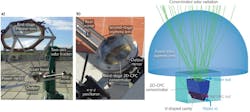Since the first report of “A sun-pumped cw one-watt laser” in 1966, optical and laser material advances have continued to improve solar-pumped laser performance.1 Until now, space-based and terrestrial applications for a “renewable energy” laser were not seriously considered; however, that notion may change with the recent 6.6X improvement in solar-pumped laser-beam brightness figure of merit achieved by researchers at the New University of Lisbon (Lisbon, Portugal).2 The brightness improvement was demonstrated using a solar-concentration configuration that incorporates a Fresnel lens and both aspheric and parabolic optics.
To date, the largest brightness figure-of-merit parameter—defined as the ratio between laser power and the product of Mx2 and My2—for an end-pumped laser (using a Fresnel lens) is 0.086 W, and 0.29 W for a side-pumped configuration (using a heliostat-parabolic mirror). Unfortunately, while high output powers of 120 W have been achieved for some solar-pumped lasers, beam-quality (M2) values are typically very high (meaning a low-quality beam) at 137 for both the x and y axes, for example, leading to a dismal brightness figure of merit of only 0.0064 W.
Lowest fundamental mode
To improve brightness of their solar-pumped laser, the Lisbon researchers used an optical solar-concentrating scheme, optimized using ZEMAX (from Radiant Zemax in Redmond, WA) and LASCAD software (from LAS-CAD in Munich, Germany), that produced laser output in the lowest fundamental mode, TEM00, for a smooth beam profile with low divergence that is easily focused to a low M2 value.
The optical system comprises a first-stage 1.0-m-diameter Fresnel lens with a 1.3 m focal length and 76% transmission efficiency mounted on an two-axis solar tracker (see figure). The laser head can be mechanically adjusted in the x, y, and z position for optimal alignment to the Fresnel lens. Concentrated solar power at the focal spot of the Fresnel lens averaged over two minutes was 590 W for a total 890 W/m2 solar irradiance at the 13 mm full-width half-maximum (FWHM) focal-point waist.
Sunlight is focused by the first-stage Fresnel lens onto a second-stage fused-silica aspheric lens with a 43 mm input face radius. The asphere further focuses the Fresnel input to a third-stage compound parabolic concentrator with 18 × 23 mm input aperture and 8 × 23 mm output aperture sitting just above the neodymium: yttrium aluminum garnet (Nd:YAG) laser rod (30 mm long, 3 mm diameter), which is placed in a V-shaped pumping cavity lined with 94% reflective silver foil. Distilled water cools both the rod and the parabolic optics at a 6 L/min flow rate.
To maximize the sunlight collected in the side-pumped scheme, the ends of the rods are antireflection-coated (R < 0.2 % at 1064 nm) and two opposing concave-concave mirrors are placed at opposite ends of the resonator cavity. Experimental results and LAS-CAD simulations for different mirror positions give the best results when one mirror is placed 100 mm from the center of the 30-mm-long rod (L1) and the other mirror is placed at positions between 100 mm and 675 mm (L2) from the center of the rod in the opposite direction. Higher power levels come at the expense of high M2 values; for example, L1/L2 = 100/100 gives 6.2 W and M2 = 4.8 for a 0.27 W brightness figure of merit, but L1/L2 = 100/675 produces 2.3 W TEM00 (M2 < or = 1.1) with the highest brightness figure of merit of 1.9.
“Economical Fresnel solar pumping schemes have only surfaced within the past six years; previous limitations in the size of Fresnel lenses made previous solar-pumped laser efforts relatively unsuccessful,” says Dawei Liang, professor at the New University of Lisbon. “Future applications in terrestrial laser sensing and space-based remote sensing can all benefit from our heliostat-parabolic mirror solar energy collection and concentration system. These concentrating optical systems, such as the 1 MW solar furnaces of PROMES-CNRS in France, might well become super solar laser power stations in the future.”
REFERENCES
1. C. G. Young, Appl. Opt., 5, 6, 993 (1966).
2. D. Liang and J. Almeida, Opt. Exp., 21, 21, 25107 (October 21, 2013).

